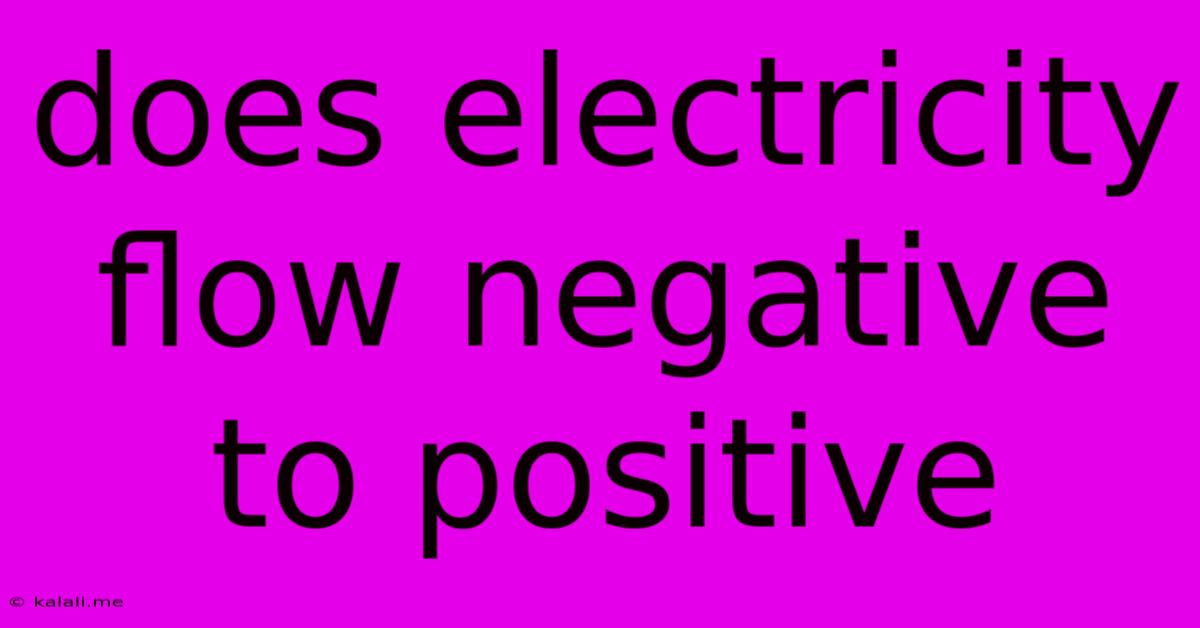Does Electricity Flow Negative To Positive
Kalali
May 31, 2025 · 3 min read

Table of Contents
Does Electricity Flow Negative to Positive? Understanding Conventional and Electron Flow
The question of whether electricity flows from negative to positive or positive to negative is a surprisingly complex one, often leading to confusion even among those familiar with basic electrical concepts. The answer depends on which current convention you're using: conventional current or electron flow.
Meta Description: This article clarifies the confusion surrounding the direction of electricity flow, explaining the differences between conventional current (positive to negative) and electron flow (negative to positive) and why both are used.
Historically, scientists understood electricity before they understood the nature of the electron. This led to the development of conventional current, which describes the flow of positive charge from a positive terminal to a negative terminal. This is the convention still widely used in circuit diagrams and many engineering applications. Think of it as a historical artifact – a simplification that worked well enough before the discovery of the electron.
However, we now know that the actual charge carriers in most conductors are electrons, which are negatively charged. Therefore, the physical movement of charge is actually from the negative terminal to the positive terminal. This is known as electron flow.
So, which is correct? Both, in a way.
Conventional Current: A Historical Perspective
- Positive to Negative: The flow of positive charge is considered from the positive terminal (higher potential) to the negative terminal (lower potential).
- Simplified Model: This model simplifies circuit analysis, particularly for early electrical engineers who didn't have a deep understanding of atomic structure.
- Widely Used: Despite its less accurate representation of the physical process, conventional current remains prevalent in many textbooks, engineering diagrams, and software simulations because it's a well-established and consistently applied system.
Electron Flow: The Physical Reality
- Negative to Positive: Electrons, being negatively charged, move from the negative terminal (higher electron concentration) to the positive terminal (lower electron concentration).
- Accurate Representation: This model reflects the actual movement of charge carriers within a conductor.
- Increasingly Popular: As our understanding of physics deepens, electron flow is becoming more prevalent in educational materials, aiming to provide a more accurate representation of electrical phenomena.
Why the Confusion Persists?
The continued use of conventional current despite its less accurate representation of electron movement stems from several factors:
- Established Practices: Years of established practices and educational materials utilizing conventional current make a complete shift difficult and potentially confusing.
- Simplicity in Calculations: For many basic circuit calculations, both models yield the same results, making the choice of convention primarily a matter of preference.
- Consistency: The key is consistency. Once you choose a convention (conventional current or electron flow), stick with it throughout your analysis to avoid contradictory results.
In Conclusion
The seemingly contradictory answers regarding the direction of electricity flow highlight the evolution of our understanding of electricity. While electron flow (negative to positive) accurately reflects the movement of charge carriers, conventional current (positive to negative) remains a widely used convention in many engineering applications. The important thing is to understand both perspectives and to maintain consistency within your chosen framework. Understanding both models empowers you to navigate the sometimes confusing world of electrical engineering and physics.
Latest Posts
Latest Posts
-
How To Find Value Of N
Jun 02, 2025
-
Puncuate Nick Name In The Name
Jun 02, 2025
-
How To Get House In Riften Skyrim
Jun 02, 2025
-
How To Backfeed A Generator Into Your House
Jun 02, 2025
-
Sed Re Error Illegal Byte Sequence
Jun 02, 2025
Related Post
Thank you for visiting our website which covers about Does Electricity Flow Negative To Positive . We hope the information provided has been useful to you. Feel free to contact us if you have any questions or need further assistance. See you next time and don't miss to bookmark.